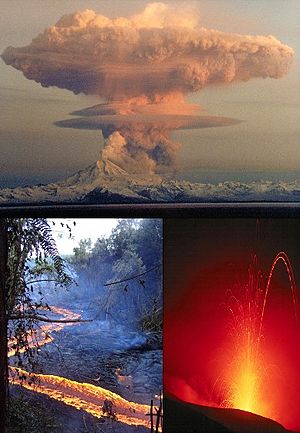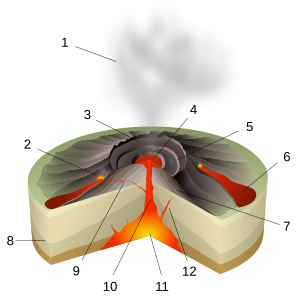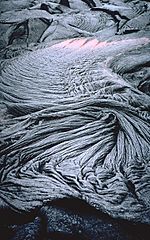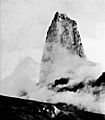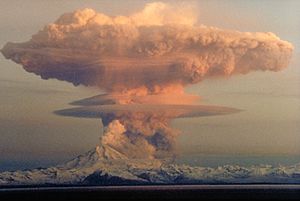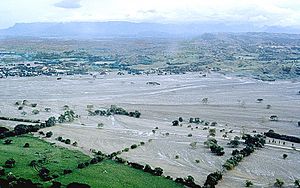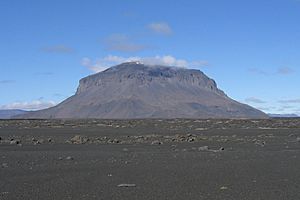Volcanic eruption facts for kids
Volcanic eruptions happen when lava, tephra (like ash, small rocks, and larger volcanic bombs), and different gases burst out from a volcano's opening or crack. Scientists who study volcanoes, called volcanologists, have found many different types of eruptions. These types are often named after famous volcanoes where they were first seen. Some volcanoes might only have one type of eruption, while others can show many different types during one active period.
There are three main kinds of eruptions:
- Magmatic eruptions are the most common. They happen when gas inside the magma (melted rock) expands and pushes the magma out.
- Phreatic eruptions are caused by steam getting super hot near magma. These eruptions don't release new magma. Instead, they blast out existing rock.
- Phreatomagmatic eruptions happen when magma and water mix directly. This is different from phreatic eruptions, where no new magma comes to the surface.
Within these main types, there are several subtypes. The weakest eruptions are Hawaiian and submarine ones. Next are Strombolian, then Vulcanian and Surtseyan. The strongest types are Pelean eruptions, followed by Plinian eruptions. The most powerful eruptions are called Ultra-Plinian. Subglacial and phreatic eruptions are named for how they happen, and their strength can vary.
Scientists use the Volcanic Explosivity Index (VEI) to measure how strong an eruption is. This scale goes from 0 to 8. Each step up means the eruption is ten times more powerful. As of December 2022, the Smithsonian Institution's Global Volcanism Program has recorded nearly 10,000 confirmed eruptions from 859 volcanoes over the last 11,700 years.
Contents
How Volcanoes Erupt
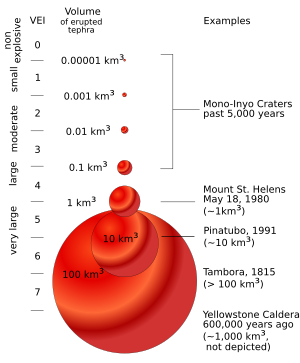
Volcanic eruptions happen in three main ways:
- Gases trapped in magma expand and escape, causing magmatic eruptions.
- Steam explosions throw out pieces of rock, causing phreatic eruptions.
- Magma cools quickly when it touches water, causing phreatomagmatic eruptions.
Eruptions can be either explosive or effusive. Explosive eruptions are powerful blasts that throw magma and ash into the air. Effusive eruptions are calmer, with lava flowing out without big explosions.
Volcanoes can have very different strengths. Calm Hawaiian eruptions have lava fountains and runny lava flows, which are usually not very dangerous. On the other hand, Plinian eruptions are huge, violent, and very dangerous. A single volcano can show many different eruption styles, both calm and explosive, even during one period of activity. Volcanoes don't always erupt straight up from a single hole at their top. Some volcanoes have eruptions from their sides or from long cracks in the ground. For example, many Hawaiian eruptions start from rift zones, which are long cracks.
Scientists used to think that magma took thousands of years to mix in a magma chamber before erupting. However, recent studies, like the one on Costa Rica's Irazú Volcano in 1963, suggest that magma can sometimes travel straight from the Earth's deep mantle to the surface in just a few months.
Measuring Eruption Strength: The VEI
The Volcanic Explosivity Index (VEI) is a scale from 0 to 8 that measures how powerful a volcanic eruption is. It's like the Richter scale for earthquakes. Each number on the VEI scale means the eruption is ten times bigger than the one before it. Most volcanic eruptions are between VEI 0 and 2.
| VEI | Plume height | Eruptive volume * | Eruption type | How often they happen | Example |
|---|---|---|---|---|---|
| 0 | Less than 100 m (330 ft) | 1,000 m3 (35,300 cu ft) | Hawaiian | Continuous | Kīlauea |
| 1 | 100–1,000 m (300–3,300 ft) | 10,000 m3 (353,000 cu ft) | Hawaiian/Strombolian | Daily | Stromboli |
| 2 | 1–5 km (1–3 mi) | 1,000,000 m3 (35,300,000 cu ft) † | Strombolian/Vulcanian | Every two weeks | Galeras (1992) |
| 3 | 3–15 km (2–9 mi) | 10,000,000 m3 (353,000,000 cu ft) | Vulcanian | Every 3 months | Nevado del Ruiz (1985) |
| 4 | 10–25 km (6–16 mi) | 100,000,000 m3 (0.024 cu mi) | Vulcanian/Peléan | Every 18 months | Eyjafjallajökull (2010) |
| 5 | Over 25 km (16 mi) | 1 km3 (0.24 cu mi) | Plinian | Every 10–15 years | Mount St. Helens (1980) |
| 6 | Over 25 km (16 mi) | 10 km3 (2 cu mi) | Plinian/Ultra-Plinian | Every 50–100 years | Mount Pinatubo (1991) |
| 7 | Over 25 km (16 mi) | 100 km3 (20 cu mi) | Ultra-Plinian | Every 500–1000 years | Tambora (1815) |
| 8 | Over 25 km (16 mi) | 1,000 km3 (200 cu mi) | Supervolcanic | Every 50,000+ years | Lake Toba (74,000 years ago) |
| * This is the smallest amount of material needed for an eruption to be in that category. These numbers are rough guesses. † There's a big jump between VEI 1 and 2; the volume increases by 100 times, not 10 times. |
|||||
Magmatic Eruptions
Magmatic eruptions happen when gas trapped in the magma expands and causes explosions. These can range from small lava fountains in Hawaii to huge Ultra-Plinian eruption columns that can reach over 30 km (19 mi) high. This is much taller than the column from the eruption of Mount Vesuvius in 79 AD that buried Pompeii.
Hawaiian Eruptions
Hawaiian eruptions are named after the Hawaiian volcanoes like Mauna Loa. They are the calmest type of volcanic event. They involve very runny basalt lava with low gas content flowing out smoothly. These eruptions build up the large, wide shape of a shield volcano. Eruptions often happen from cracks (called fissure vents) around the volcano's top, not just from the main crater.
Hawaiian eruptions often start as a long line of fire along a crack, called a "curtain of fire." This then settles down as the lava focuses on a few vents. Eruptions from the main vent often create tall lava fountains, sometimes hundreds of meters high. The lava pieces usually cool in the air, forming cindery scoria. But if there's a lot of lava, it can stay hot and form spatter cones when it lands. Hawaiian eruptions can last a very long time. For example, Puʻu ʻŌʻō on Kilauea erupted continuously for over 35 years. Another cool feature is active lava lakes, which are pools of hot lava with a thin, cool crust.
The lava flows from Hawaiian eruptions are basaltic and come in two main types. Pahoehoe lava is smooth and can look like ropes or billows. It can flow as a sheet or in snaking columns. A'a lava is thicker and moves slower. A'a flows can be 2 to 20 m (7 to 66 ft) thick. The outside of A'a flows cools into a rough, rocky crust, which keeps the inside hot. A'a lava moves by its front breaking off due to pressure, and the rest of the flow moves forward. Pahoehoe lava can turn into A'a lava if it gets thicker or moves faster, but A'a lava never turns back into pahoehoe.
Hawaiian eruptions create unique volcanic materials. Small, teardrop-shaped pieces of volcanic glass called Pele's tears (named after the Hawaiian volcano goddess, Pele) are formed when lava cools quickly in the wind. In strong winds, these can stretch into long strands called Pele's hair. Sometimes, basalt lava becomes reticulite, which is the lightest rock on Earth.
Even though they're named after Hawaii, Hawaiian eruptions happen elsewhere. The tallest lava fountain ever recorded was at Mount Etna in Italy in 2013, reaching about 2,500 m (8,200 ft) high.
Volcanoes with Hawaiian activity include:
- Puʻu ʻŌʻō, a smaller cone on Kilauea in Hawaiʻi, which erupted from 1983 to 2018.
- Mount Etna, Italy.
- Mount Mihara in 1986.
Strombolian Eruptions
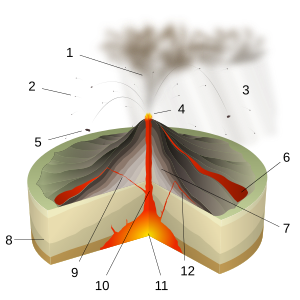
Strombolian eruptions are named after the Stromboli volcano, which has been erupting almost constantly for hundreds of years. These eruptions are caused by gas bubbles bursting inside the magma. These small gas bubbles join together to form larger "gas slugs." When these big bubbles reach the surface, the change in air pressure makes them burst with a loud pop. This throws magma into the air, similar to a soap bubble popping. Because of the high gas pressure, these eruptions happen in short, explosive bursts with loud sounds, often every few minutes.
The term "Strombolian" is sometimes used for many types of eruptions, but true Strombolian eruptions are short, explosive blasts of moderately thick lava. The lava is often thrown high into the air, sometimes hundreds of meters. The lava from Strombolian eruptions is a type of thick basaltic lava, and it mostly forms scoria (bubbly, dark rock). These eruptions are relatively calm and don't usually damage the volcano itself, so they can continue for thousands of years. This also makes them one of the least dangerous types of eruptions.
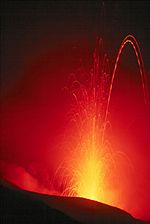
Strombolian eruptions throw out volcanic bombs and small rock fragments (lapilli) that fly in curved paths before landing around the volcano's vent. The steady build-up of these fragments creates cinder cones made entirely of basaltic pyroclasts (volcanic rock pieces).
Strombolian eruptions are similar to Hawaiian eruptions, but they are noisier. They don't create long-lasting eruptive columns and don't produce things like Pele's tears or Pele's hair. They also create fewer molten lava flows, though the erupted material can form small streams.
Volcanoes known to have Strombolian activity include:
- Parícutin, Mexico, which erupted from a cornfield in 1943. Scientists were able to watch its entire life cycle.
- Mount Etna, Italy, which has shown Strombolian activity in recent eruptions.
- Mount Erebus in Antarctica, the southernmost active volcano, which has been erupting since 1972.
- Stromboli itself, which has been active for over a thousand years.
Vulcanian Eruptions
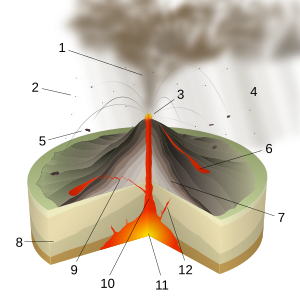
Vulcanian eruptions are named after the Vulcano volcano. They were described by Giuseppe Mercalli after its eruptions from 1888–1890. In these eruptions, thick magma inside the volcano makes it hard for gases to escape. Like Strombolian eruptions, this causes high gas pressure to build up. Eventually, this pressure breaks the cap holding the magma down, leading to an explosive eruption. However, unlike Strombolian eruptions, the lava pieces thrown out are not smooth. This is because Vulcanian magma is thicker and contains more broken rock from the old cap. They are also more explosive than Strombolian eruptions, with eruptive columns often reaching 5 and 10 km (3 and 6 mi) high. The rock from Vulcanian eruptions is usually different from basalt, being more andesitic to dacitic.
Vulcanian activity often starts with short, powerful explosions that last from a few minutes to a few hours. These blasts throw out volcanic bombs and large blocks of rock. These explosions wear down the lava dome (a dome of hardened lava) that holds the magma in. Once the dome breaks apart, the eruptions become quieter and more continuous. So, a growing lava dome can be a sign of a coming Vulcanian eruption. Its collapse can send pyroclastic material (hot rock and gas) down the volcano's sides.
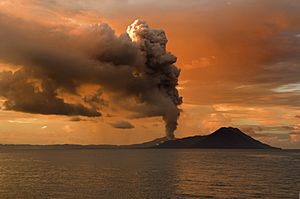
Close to the vent, you'll find large volcanic blocks and bombs. "Bread-crust bombs" are common. These are deeply cracked volcanic chunks that form when the outside of the lava cools quickly into a glassy shell, but the inside keeps expanding and cracking the surface. Most Vulcanian deposits are fine ash. The ash isn't spread very far, and its large amount shows that the magma broke into many small pieces due to high gas content. Sometimes, these eruptions are caused by water mixing with magma, making them partly hydrovolcanic.
Volcanoes that have shown Vulcanian activity include:
- Sakurajima, Japan, which has been erupting almost continuously since 1955.
- Tavurvur, Papua New Guinea, part of the Rabaul Caldera.
- Irazú Volcano in Costa Rica during its 1965 eruption.
- Anak Krakatoa, Indonesia, which has had repeated Vulcanian activities since 1930.
Vulcanian eruptions are thought to make up at least half of all known eruptions in the last 11,700 years.
Peléan Eruptions
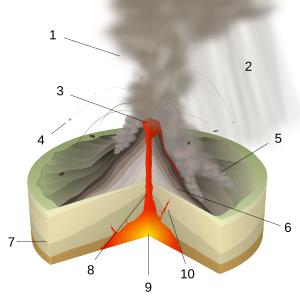
Peléan eruptions are named after Mount Pelée in Martinique. A Peléan eruption there in 1902 was one of the worst natural disasters in history. In these eruptions, a lot of gas, dust, ash, and lava pieces are blasted out of the volcano's main crater. This is caused by the collapse of rhyolite, dacite, and andesite lava domes, which often create large eruptive columns. A sign of a coming eruption is the growth of a "Peléan spine," a bulge at the volcano's top before it collapses. The material then falls down, forming a fast-moving pyroclastic flow (a mix of hot rock blocks and ash). These flows can rush down the mountain at speeds over 150 km (93 mi) per hour. These fast-moving flows make Peléan eruptions very dangerous, as they can destroy towns and cause many deaths. The 1902 eruption of Mount Pelée killed over 30,000 people and completely destroyed the town of St. Pierre.
Peléan eruptions are known for their glowing hot pyroclastic flows. The way a Peléan eruption works is similar to a Vulcanian eruption. However, in Peléan eruptions, the volcano's structure can hold more pressure. This means the eruption happens as one huge explosion instead of several smaller ones.
Volcanoes known to have Peléan activity include:
- Mount Pelée, Martinique. The 1902 eruption was deadly and was preceded by lava dome growth.
- Mayon Volcano, the Philippines' most active volcano. It has had many types of eruptions, including Peléan ones.
- The 1951 eruption of Mount Lamington. This volcano wasn't even known before this eruption, which killed over 3,000 people.
- Mount Sinabung, Indonesia, which has shown pyroclastic flows and lava dome collapses since 2013.
-
Pyroclastic flows at Mayon Volcano, Philippines, 1984
Plinian Eruptions
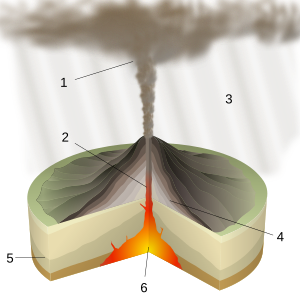
Plinian eruptions are named after the historic eruption of Mount Vesuvius in 79 AD. This eruption buried the Roman towns of Pompeii and Herculaneum. The name also comes from Pliny the Younger, who wrote about the event. Plinian eruptions start deep in the magma chamber. Gases dissolved in the magma expand and form bubbles as they rise. These bubbles grow and join together. Once they fill about 75% of the magma channel, they explode. The narrow channel forces the gases and magma upwards, creating a tall eruption column. The speed of the eruption is controlled by the gas in the column. The pressure can crack surface rocks, making the gases shoot out even faster.
These huge eruption columns are the main feature of a Plinian eruption. They can reach 2 to 45 km (1 to 28 mi) into the atmosphere. The densest part of the plume, right above the volcano, is pushed up by expanding gas. Higher up, the plume expands and becomes less dense. Heat and expanding volcanic ash push it even higher into the stratosphere. At the very top, strong winds carry the plume away from the volcano.
These very explosive eruptions usually involve gas-rich dacitic to rhyolitic lavas and happen most often at stratovolcanoes. Eruptions can last from hours to days. Longer eruptions usually happen with volcanoes that have more felsic (light-colored, silica-rich) magma. While typically linked to felsic magma, Plinian eruptions can also occur at basaltic volcanoes if the magma chamber has layers rich in silicon dioxide or if magma rises quickly.
Plinian eruptions are similar to Vulcanian and Strombolian eruptions, but instead of separate explosions, Plinian eruptions create continuous eruption columns. They are also like Hawaiian lava fountains because both produce steady columns of material pushed up by growing bubbles.
Areas affected by Plinian eruptions get covered in a thick layer of pumice (light, porous volcanic rock) and ash. This can cover an area from 0.5 to 50 km3 (0 to 12 cu mi) in size.
However, the most dangerous parts of Plinian eruptions are the pyroclastic flows. These are hot, fast-moving currents of gas and rock that rush down the mountain at speeds up to 700 km (435 mi) per hour. They can extend for hundreds of kilometers. The hot material from the volcano's top can also melt snow and ice, mixing with tephra to form lahars. Lahars are fast-moving mudflows, like wet concrete, that can travel as fast as a river rapid.
Major Plinian eruptions include:
- The 79 AD eruption of Mount Vesuvius, which buried Pompeii and Herculaneum. This is the classic example of a Plinian eruption.
- The 1980 eruption of Mount St. Helens in Washington, which was a VEI 5 Plinian eruption.
- The strongest eruptions, VEI 8, are called "Ultra-Plinian." An example is the Lake Toba eruption 74,000 years ago, which produced 2,800 times more material than Mount St. Helens in 1980.
- Hekla in Iceland, which had a basaltic Plinian eruption in 1947–48.
- Pinatubo in the Philippines on June 15, 1991, which produced a 40 km (25 mi) high eruption column.
- Kelud, Indonesia, which erupted in 2014, causing economic problems across Java.
Phreatomagmatic Eruptions
Phreatomagmatic eruptions happen when water and magma interact. They are caused by the magma shrinking quickly when it touches water. This is different from magmatic eruptions, which are caused by gas expansion. The big temperature difference between water and lava leads to violent interactions that cause the eruption. The rocks produced by phreatomagmatic eruptions are thought to be more regular in shape and finer-grained than those from magmatic eruptions.
Scientists still debate exactly how phreatomagmatic eruptions work. Some believe that "fuel-coolant reactions" are more important than just thermal shrinking. These reactions can break the volcanic material into tiny pieces by creating shock waves, which widen cracks and increase the surface area. This leads to rapid cooling and explosive eruptions.
Surtseyan Eruptions
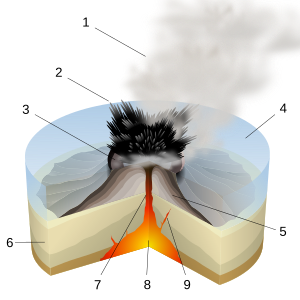
A Surtseyan eruption is a type of volcanic eruption that happens when water and lava interact in shallow water. It's named after the island of Surtsey off the coast of Iceland, which formed from such an eruption in 1963. Surtseyan eruptions are like Strombolian eruptions on land, but because they happen in water, they are much more explosive. When water is heated by lava, it quickly turns into steam and expands violently. This breaks the magma into fine ash. Surtseyan eruptions are common for volcanoes in shallow ocean water, but they can also happen on land if rising magma hits an aquifer (an underground water source). The rocks from Surtseyan eruptions are usually oxidized (rusted) palagonite basalts. Like Strombolian eruptions, Surtseyan eruptions are usually continuous or happen in regular bursts.
A key feature of a Surtseyan eruption is the formation of a pyroclastic surge (also called a "base surge"). This is a cloud of gas and ash that spreads out low to the ground, along with the main eruption column. Base surges happen when a steam-filled eruption column collapses due to gravity. The densest part of the cloud is closest to the vent, making it wedge-shaped. These moving clouds leave behind dune-shaped piles of rock. Sometimes, these piles are disturbed by "bomb sags," which are dents made by rocks thrown out by the explosion. Wet, round ash clumps called accretionary lapilli are another common sign of these surges.
Over time, Surtseyan eruptions can form maars, which are wide, shallow volcanic craters dug into the ground. They can also form tuff rings, which are circular structures made of rapidly cooled lava. These structures are created by eruptions from a single vent. However, if eruptions happen along cracks in the Earth, they can create long rift zones. These eruptions tend to be more violent, like the 1886 eruption of Mount Tarawera. Littoral cones are another feature of water-lava interactions. They form when lava gets into cracks, superheats, and explodes, breaking the rock and depositing it on the volcano's side. Repeated explosions build up the cone.
Volcanoes known to have Surtseyan activity include:
- Surtsey, Iceland. This volcano grew from the ocean floor in 1963. Its first eruptions were very explosive, but as the volcano grew, the lava interacted less with water and more with air, becoming more like Strombolian eruptions.
- Ukinrek Maars in Alaska (1977) and Capelinhos in the Azores (1957) are examples of Surtseyan activity above water.
- Mount Tarawera in New Zealand erupted along a crack in 1886, killing 150 people.
- Ferdinandea, an seamount in the Mediterranean Sea, appeared above sea level in 1831. It didn't form strong enough rock to resist erosion and soon disappeared underwater again.
- The underwater volcano Hunga Tonga in Tonga broke the surface in 2009. Both of its vents showed Surtseyan activity.
-
The fissure formed by the 1886 eruption of Mount Tarawera, an example of a fracture zone eruption.
Submarine Eruptions
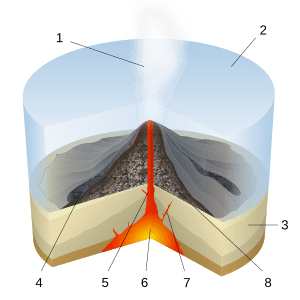
Submarine eruptions happen underwater. About 75% of all volcanic eruptions happen underwater near mid-ocean ridges. However, it was hard to study deep-sea volcanoes until the 1990s, when new technology made it possible to observe them.
Submarine eruptions can create seamounts, which are underwater mountains. Sometimes, these seamounts grow tall enough to break the surface and form volcanic islands.
Underwater volcanism is caused by different things. Volcanoes near plate boundaries and mid-ocean ridges form when mantle rock melts as it rises to the Earth's crust. Eruptions near subducting zones (where one plate slides under another) happen because the sinking plate adds water and other gases to the rising plate, which lowers its melting point. These different processes create different types of rock. Mid-ocean ridge volcanoes mainly produce basaltic rock, while subduction zone volcanoes produce more explosive and thicker calc-alkaline rock.
The speed at which mid-ocean ridges spread varies a lot. For example, the Mid-Atlantic Ridge spreads about 2 cm (0.8 in) per year, while the East Pacific Rise spreads up to 16 cm (6 in) per year. Faster spreading likely means more volcanism. For a long time, scientists couldn't study seamount eruptions. But then, new hydrophone (underwater microphone) technology allowed them to "listen" to sound waves (T-waves) released by submarine earthquakes linked to underwater eruptions. Land-based seismometers can't detect sea earthquakes smaller than a magnitude 4, but sound waves travel well in water over long distances. A system in the North Pacific, originally for detecting submarines, finds an underwater eruption event every 2 to 3 years on average.
The most common underwater lava flow is pillow lava, which is rounded and named for its unusual shape. Less common are glassy, flat sheet flows, which mean larger eruptions. Volcanic sedimentary rocks are common in shallow water. As tectonic plates move volcanoes away from their source, eruptions slow down. Water erosion then wears the volcano down. The final eruptions often cover the seamount in alkalic flows. There are about 100,000 deepwater volcanoes in the world, but most are no longer active. Some examples of seamounts are Kamaʻehuakanaloa Seamount, Bowie Seamount, Davidson Seamount, and Axial Seamount.
Subglacial Eruptions
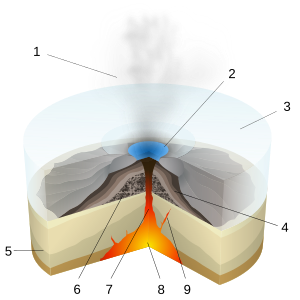
Subglacial eruptions happen when lava and ice interact, often under a glacier. This type of volcanism occurs in very cold, high places. It's thought that subglacial volcanoes that aren't actively erupting still release heat into the ice above them, creating meltwater. This meltwater means that subglacial eruptions often cause dangerous jökulhlaups (floods) and lahars (mudflows).
The study of volcanoes under ice is still quite new. Early reports described unusual flat-topped, steep-sided volcanoes (called tuyas) in Iceland. These were thought to have formed from eruptions under ice. The first English paper on this topic was published in 1947 by William Henry Mathews. He described the Tuya Butte field in British Columbia, Canada. The process that builds these structures, as he figured out, starts with the volcano growing under the glacier. At first, the eruptions are like those in the deep sea, forming piles of pillow lava at the base. Some lava shatters when it touches the cold ice, forming a glassy, broken rock called hyaloclastite. After a while, the ice melts into a lake. Then, more explosive Surtseyan activity begins, building up sides made mostly of hyaloclastite. Eventually, the lake boils away from the continuous eruptions. The lava flows then become more effusive and thicker as they cool slowly, often forming columnar jointing (rock columns). Well-preserved tuyas, like Hjorleifshofdi in Iceland, show all these stages.
Volcano-ice interactions create various structures, whose shapes depend on complex eruption and environmental factors. Glacial volcanism is a good way to figure out where ice used to be, making it an important climate marker. Since these volcanoes are stuck in ice, there are worries that as glaciers melt worldwide, tuyas and other structures might become unstable, leading to large landslides. Evidence of volcanic-glacial interactions is clear in Iceland and parts of British Columbia. It's even possible they play a role in the melting of ice ages.
Volcanic products from ice interactions have been found in Iceland, British Columbia, Hawaii, Alaska, the Cascade Range in North America, South America, and even on the planet Mars. Volcanoes known to have subglacial activity include:
- Mauna Kea in tropical Hawaii. There's evidence of past subglacial eruptions on its summit from about 10,000 years ago, when the summit was covered in ice.
- In 2008, the British Antarctic Survey reported a volcanic eruption under the Antarctica ice sheet 2,200 years ago. This is believed to be the biggest eruption in Antarctica in the last 10,000 years.
- Iceland, known for both glaciers and volcanoes, often has subglacial eruptions. For example, an eruption under the Vatnajökull ice cap in 1996 happened under about 2,500 ft (762 m) of ice.
- Scientists have suggested that there might be subglacial volcanoes on Mars as part of the search for life on Mars. They have compared possible sites on Mars to similar features in Iceland.
Phreatic Eruptions
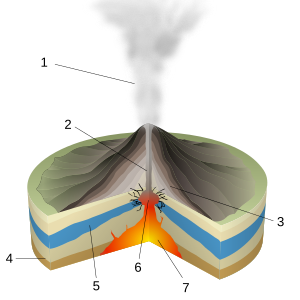
Phreatic eruptions, also called steam-blast eruptions, are caused by expanding steam. They happen when cold ground or surface water touches hot rock or magma. The water gets superheated and explodes. This breaks the surrounding rock and blasts out a mix of steam, water, ash, volcanic bombs, and volcanic blocks. The main thing about phreatic explosions is that they only throw out pieces of existing solid rock from the volcano's opening. No new magma comes out. Because they are caused by rock cracking under pressure, phreatic activity doesn't always lead to a full eruption. If the rock is strong enough, it might just crack and weaken, setting the stage for future eruptions.
Phreatic eruptions are usually weak, but there have been exceptions. They often happen before other volcanic activity. Sometimes, earthquakes can trigger phreatic events. They can also follow along cracks in the ground called dike lines. Phreatic eruptions can create "base surges" (fast-moving clouds), lahars (mudflows), avalanches, and a "rain" of volcanic blocks. They can also release dangerous toxic gas that can harm anyone nearby.
Volcanoes known to show phreatic activity include:
- Mount St. Helens, which had phreatic activity just before its huge 1980 Plinian eruption.
- Taal Volcano, Philippines, in 1965 and 2020.
- La Soufrière of Guadeloupe (1975–1976).
- Soufrière Hills volcano on Montserrat, West Indies (1995–2012).
- Poás Volcano, which has frequent geyser-like phreatic eruptions from its crater lake.
- Mount Bulusan, known for its sudden phreatic eruptions.
- Mount Ontake, all its historical eruptions have been phreatic, including the deadly 2014 eruption.
- Mount Kerinci, Indonesia, which has almost yearly phreatic eruptions.
See also
 In Spanish: Erupción volcánica para niños
In Spanish: Erupción volcánica para niños


